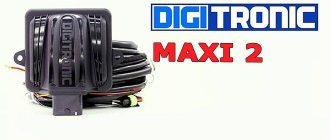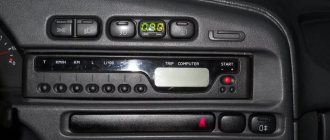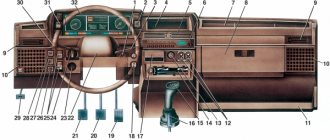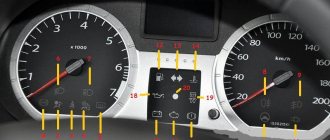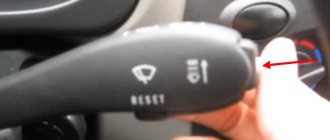Every car owner wants to save on fuel, especially in modern conditions. Of course, it is quite possible to realize such an idea if you install gas-cylinder equipment. Moreover, in specialized reputable services, where real professionals work, such work is completed in a matter of time.
Of course, before installing LPG, drivers should understand whether propane or methane is suitable as a fuel for your car’s engine, whether it can shorten the service life of the internal combustion engine as a whole, etc. As experienced experts say, problems can only be avoided when the owner of the vehicle means will be able to select the equipment correctly - then it will not cause any harm to the engine. Consequently, the owner will be able to save significantly.
Basic tools for setting up 4th generation HBO. Peculiarities
In addition to installing the unit, it is necessary to configure it, since setting up the 4th generation gas equipment plays an important role. If you want to know how to connect a 4th generation HBO with your own hands, how to adjust a 4th generation HBO yourself, you need to carefully study the intricacies of this issue.
To set up the equipment, you will need some parts:
- a program designed for this purpose;
- a special cable that will allow connection to the control unit of the unit;
- diagnostic cable.
How to check the performance of HBO injectors
It is possible to check gas injectors in detail (injection/opening time, throughput) only when connecting diagnostic equipment, as well as after dismantling the entire ramp and checking it on a special stand in a car service center. Or build a homemade stand.
Independently identifying which injector is not working and the presence of leaks (tightness) is only possible by alternately disconnecting the connectors/chips and removing the hoses from the outlet fittings. It is highly not recommended to use such methods!
Settings options
In order for the adjustment of the 4th generation HBO to take place correctly and competently, you need to understand that you will need to choose two options, which, in fact, will allow you to do this.
- For example, it is always possible to correctly configure the LPG, having only a cable designed to adjust the unit, doing this by changing the injection time. When this option is used, older versions of programs are ideal.
- You can achieve success using a diagnostic scanner, this is done by fuel correction. Of course, if you have a diagnostic scanner or adapter at hand, you can always configure it with one program or another.
It is important to know. It should be understood that the load on the engine is not only an increase in speed, as many drivers believe. This statement is not at all true, since when accelerating in neutral gear, of course, the speed will soar to the limit, but at the same time the load is low.
Gas equipment
It is naive to think that switching from gasoline to gas consumption means just pouring liquefied propane into the gas tank. Apart from individual models specially designed for this purpose, factory cars, as conceived by the developers, consume gasoline, and the normal functioning of all mechanisms and components is calculated on its use. If you change the situation and start saving, you must first install and configure special gas equipment - abbreviated as LPG.
This functional unit consists of several automatic systems, the operation of which, after appropriate preparation, is fully automated and does not differ in ease and comfort of use from the usual equipment of a car. The GBO design includes:
- Reducer (reduces and equalizes the pressure between the gas cylinder and the engine).
- A computerized control unit that distributes and organizes all work.
- Solenoid valves, sensors, wire, program, probes and other electronic components necessary for work.
- Hoses, plugs and other auxiliary parts.
Rough adjustment for load. Peculiarities
When this option is selected, it is customary to change the cells; this is done not by revolutions, but solely by injection time. All that is required is to remember the fuel injection time, this is done at certain points in the movement, after which you need to switch to gas. This is how the 4th generation gas equipment is configured, the nozzles are adjusted and the work in general occurs. In addition, the 4th generation HBO, namely the pressure adjustment of the reducer, plays an equally important role.
It is important to know! As for the working pressure after the auto-calibration procedure, it will be automatically set, and at the level at which the adjustment is carried out. Regarding the minimum pressure, this is the gas pressure below which the system will automatically switch the vehicle to gasoline.
Attention: Every driver must understand that adjustment of the LPG gearbox, as a rule, is required only at the time of installation of the unit. But after one hundred thousand kilometers, it is necessary to perform diagnostics. It is also possible to service 4th generation gas equipment with your own hands, but only if you have the appropriate experience, knowledge, and equipment that allows you to do this.
If you consult with specialists, you can find out how to remove 4th generation HBO with your own hands, doing it at home. You always need to know that the proper operation of the unit does not depend on the quality of the electronic settings, as for some reason most car owners believe. Indeed, after a certain period of operation, valves and membranes begin to wear out, resulting in excessive gas consumption.
But this unpleasant moment can be delayed if you learn about the intricacies of proper operation of the equipment. For example, as for starting the engine, this should always happen exclusively on the car’s native fuel, which is often forgotten. Only at the moment when the engine temperature reaches thirty degrees can you switch to gas.
This is explained by the fact that the gearbox membrane freezes in practice at low temperatures. Therefore, the gearbox must be connected to the antifreeze lines, and only this way. If you want to configure the 4th generation LPG gearbox yourself, you need to realize in advance that this is not as easy to do as it seems.
Before doing such work, do not forget to warm up the engine, after which you can turn off the gasoline supply. If there is a need to adjust the sensitivity of the gearbox, then you need to unscrew the sensitivity regulator, and the procedure is performed at the moment until the idle speed values change.
You may be interested >> Diagnostics of gas equipment of a car
Next you need to tighten the regulator and check the setting. All you need to do is press the accelerator pedal - the engine should not react to such an action, and accordingly, you should notice the absence of delays and jerks. Of course, if you managed to configure the 4th generation LPG yourself, and you did everything correctly, then the internal combustion engine will work stably and accurately.
Signs and possible causes of malfunctions
Symptoms of a malfunction of one or more injectors may include:
- high fuel consumption;
- deterioration of the dynamic characteristics of the machine;
- unstable engine operation, internal combustion engine is tripping (one or a couple of injectors do not work);
- dips when pressing the gas pedal;
- malfunctions of various sensors, appearance of “Check engine” errors (for example, MAP sensor);
- knocking in the injectors (they “click” loudly);
- gas leaks through injectors (pouring/poisoning);
- The car stops idling and the injectors do not turn on.
The reasons for this may be:
- wear of the damper rubber rings on the valve stems (this causes the injectors to knock);
- development of the seat (seat) of the valve or its locking rubber;
- wear of the rod (also called piston, anchor) or sleeve (also called core, cylinder, bulb);
- armature jamming in the cylinder;
- weakening of the elasticity of the piston return spring;
- failure of the electromagnetic coil (solenoid);
- violation of the integrity of the electrical wiring.
Adjustment
- Adjusting Valtek gas injectors begins with unscrewing the adjusting jets from them. This can be done using a 12 key.
- Next, install the extension rod and secure the dial indicator to the ramp using the adapter sleeve.
- Check that the extension rod is touching the gas injector rod. If the arrow of the device begins to move, it means that contact has been achieved.
- Set “0” on the indicator device. Apply power to the controlled part for up to 1 second .
Do not apply power for more than 1 second, this may lead to failure of the part that is being adjusted!
- Write down the value obtained on the dial indicator as a result of the measurement.
- Do the above for all engine gas nozzles, recording the values.
- Next, using an internal hexagon screw located at the end of the electric coil, we set the required stroke of the rods. By rotating clockwise, we reduce the stroke of the rod, and vice versa, if we rotate counterclockwise, we increase the stroke. We set the same stroke of the rods, but not more than 0.7 mm, according to the recommendations of Valtek.
Below is a table for adjusting the armature stroke depending on engine power.
- After adjusting all gas injectors, measurements must be repeated. And, if necessary, adjust to obtain the same stroke for all injectors.
After obtaining the desired result, screw the jets back in and install the assembled ramp back into the car. We connect all the lines, open the flow valve on the cylinder, wash the system and turn on the ignition. When gas leaks are detected, we fix them without fail.
If you still have any questions, ask them in the comments to the article, and we will be happy to answer them.
What is an injector emulator
For 2nd generation gas internal combustion engines, an electronic device is installed to simulate gasoline injectors. This device is called an LPG injector emulator. For the 3rd and 4th generation it is integrated into the electronic gas control unit.
Emulators depend on the number of engine cylinders because it is necessary to read the signal to supply the appropriate fuel to each cylinder using a switch on the dashboard. This device allows you to set the interval for switching from gasoline to a gas mixture. You can set the delay in the range of 0-5 seconds.
The task of the emulator, when turning off the gasoline injectors, is to transmit signals to the control unit that simulate the operation of the injectors.
How can you distinguish original Lovato equipment from counterfeits?
When purchasing gas equipment under the Lovato brand, you should be especially careful, since, unfortunately, there are fakes on the market. Of course, the manufacturer does not bear any responsibility for counterfeit goods, which, as a rule, are made from low-quality components and are sold at a deliberately lower price. That is why, in order to avoid the risk of installing a counterfeit on your car, it is important to take into account the following features of the original LPG:
- The Lovato symbol must be stamped on the solenoids, coils and gearbox.
- The gear housing must contain a logo and part number
- Each gas cylinder installation unit has a corresponding document
- The numbers on the gearbox and on the passport must match
Step-by-step calibration algorithm
Note! The fuel level sensor is calibrated on an empty gas cylinder. If there are fuel residues in the cylinder, calibration should not be started!
Calibration of the gas level sensor is carried out as follows:
- Apply voltage to the gas/petrol switch button. This can be done by turning on the car ignition and waiting for the button indication to light up. It is not necessary to start the car.
- Press the gas/petrol switch button and wait for the sound signal.
- Turn off the ignition for three seconds without releasing the button.
- After the button enters the programming mode (accompanied by an indication of an increase in the fuel level from the minimum value to the maximum and vice versa).
- Fill the gas cylinder full to the cut-off point.
- Turn on the ignition; you do not need to start the car.
- If calibration is successful, the indication of the increase in fuel level from the minimum to the maximum value and back should go through twice, after which it will display “full tank”. All green indicators should be lit.
If the sequential growth of the indicators on the button continues 5 times, then something went wrong and the calibration could not be completed.
If the setup process is not successful, you should understand the reasons, be sure to study the errors that are present in the electronic control unit and, after eliminating them, repeat the process of calibrating the gas sensor indicator.
Source
Fuel level sensor calibration
Modern LPG systems monitor the presence of gas in the cylinder by lighting the LEDs on the gas/gasoline switch button, which is located in the vehicle interior. This convenient method allows the motorist to monitor the presence of gas in the cylinder without leaving the cab. But sometimes the gas level indicator displays completely incorrect values, in which case calibration of the fuel level sensor is required.
General information
Gas injectors are special gas equipment units that are responsible for the dosage of fuel, essentially being high-speed valves. Thanks to their proper operation, the required gas-air mixture ratio in the internal combustion engine is ensured. Such mechanisms began to be used in the 4th generation of HBO.
Some of the most popular are stock models from the companies Valtek (Valtek), Rail (Reil), Digitronic (Digitronic), OMVL (OMVL), Lovato (Lovato). Their undoubted advantage is that they are easy to repair, which consists of washing, replacing the repair kit and adjusting, unlike non-separable injectors such as BRC (BRS), Barracuda (Barracuda) and the like.
How much will HBO cost?
The cost of gas equipment for a car depends on the kit. It includes:
- electronic control unit;
- gearbox;
- balloon;
- filling device;
- multivalve;
- filter;
- nozzles;
- highways;
- switch button.
For each engine, a kit is selected either from one manufacturer or prefabricated. For example: the ECU is from Stag, and the gearbox, cylinder and injector are from Lovato.
The price of HBO is affected not only by its layout, but also by the type of cylinder. It can be cylindrical - installed in the trunk, or toroidal - for installation in a niche instead of a spare wheel. The latter is more expensive.
The more powerful and complex the engine, the more expensive the gas equipment will cost. The price of equipment is from 11 thousand rubles.
Types and device
The variety of injectors in terms of technical characteristics, as well as by manufacturer, is large. There are examples with a rare device (for example, “petal” injectors from Matrix), but there are two main types:
AEB rack device
membrane (disc-shaped), popular representatives AEB (AEB) ECO/EVO, Landi Renzo (Landi Renzo) GIRS 12;
Barracuda injector design
rod ones - Valtak (Valtek) type 30 and many similar ones, for example Rail. In the same series are such samples as Barracuda.
The operating principle of gas injectors is essentially the same; signals (short-term electrical impulses) from the equipment's ECU are sent to the electromagnet coil. During this process, the rubberized core/piston in the rod or plate inside the nozzle moves, opening the seat hole for gas to escape. Closing occurs under the influence of a return spring.
Since the fuel at the outlet of the gearbox is already in an evaporated state, its atomization, as in the gasoline version, is not required. The volume of gas supplied is a multiple of the amount of gasoline (about 200 times). For this purpose, the cross-section of the dosing holes of gas injectors is made much larger, and also, unlike gasoline injectors, the coil resistance of the gas part is 1-3 Ohms, because the control process occurs as a result of pulse width modulation (PWM). The petrol one has 15-16 ohms.
Material
An important parameter is the material of the product. The operation of all equipment is carried out in various temperature fluctuations: from -200C with a cold engine to +1000C after warming up. The gas fuel itself contains impurities (for example, paraffin or oil), which lead to contamination of parts.
Under these conditions, the metal will deform, which is not acceptable. For example, one of the elements of an injector is a plunger that creates fuel pressure. It makes translational movements, with a stroke length of 0.5 mm. Any change in physical dimensions will affect the performance of the system. Therefore, it is desirable that the material has a minimum coefficient of thermal expansion.
In budget versions of injectors, it is possible to reduce the plunger stroke to 15-20%. This shortens the life of the injector, increasing its wear.



